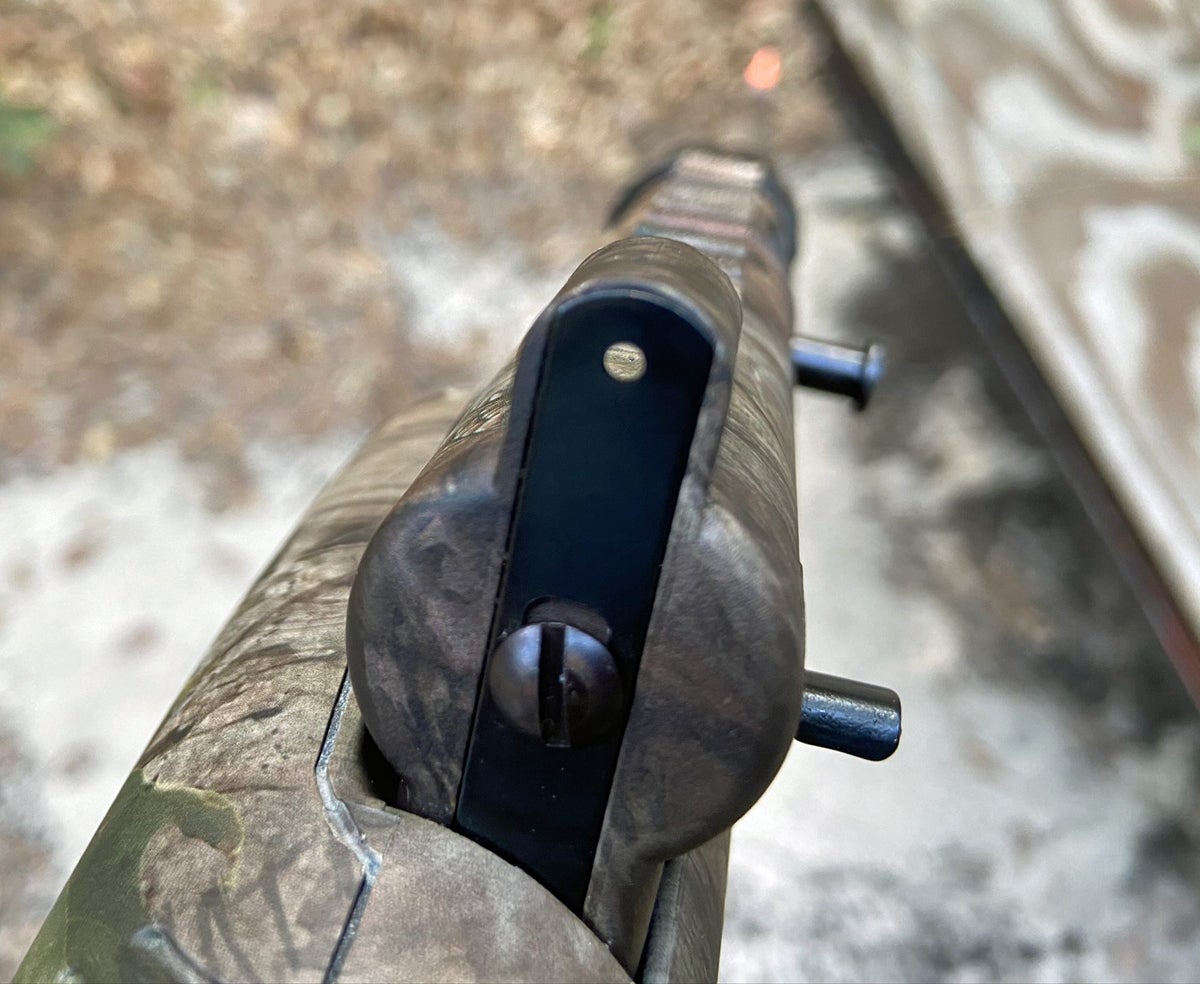One of my uncles has a favorite saying, usually employed in a tongue-in-cheek manner when things are going rough: When you’re having fun, it’s hard to stop. Happily, it’s also true when actual fun is being had — which is exactly what happens when a new rifle shows up at Old Tymers Gun Shop with my name on it. This time, it was a brand-spanking new Henry AR-7 Survival rifle, a little semi-auto takedown job whose parts all store in the butt stock (along with a pair of magazines).
This isn’t a review — that will come later. This is more of an introduction, for those who may not have had the chance to become acquainted with the AR-7 “survival rifle.”

(Photo © Russ Chastain)
This rifle was originally an Armalite product (hence the “AR” in the name) in 1959 and has been manufactured by at least five different companies over the years. Henry began building it in 1997, and is still going strong with it. The rifle comes in a cool little cardboard box with a carry handle, as seen above.

(Photo © Russ Chastain)
Mine came in the True Timber Kanati camo pattern, with all the good stuff stored inside the butt stock. There’s not a lot to see here other than the stock and the end cap (which doubles as the butt pad). The butt pad sometimes seems a touch stubborn when it’s time to remove it, but it’s not really a tight fit.

(Photo © Russ Chastain)
Removing the butt pad reveals the gun’s other parts, nested inside. I found the AR-7 easy to assemble and operate.

(Photo © Russ Chastain)
This is one of the coolest takedown designs ever, even if it isn’t the easiest on the eyes. The barrel — which is lightweight because it’s mostly made of ABS plastic around a slim steel rifled tube — is secured to the receiver via a black knurled locknut which you tighten by hand. The receiver is held into the stock by a thumb screw in the pistol grip, the bottom end of which is visible in the photo above.
It doesn’t take down as quickly as the Ruger 10/22 Takedown — especially the Backpacker version I reviewed a few months ago — but it stores more conveniently and weighs a full pound less at 3.5 pounds (same as factory spec; verified with my own scale).

(Photo © Russ Chastain)
After assembly, the rifle is 1/4-inch shy of three feet long, and is perhaps the only takedown 22 with a stock that actually fits my long arms. I also like the super-fat pistol grip portion of the stock.
Both of those positive assets are due to storing the barrel inside the butt stock.

(Photo © Russ Chastain)
Another side effect of in-stock barrel storage is the off-center receiver, which is one of the first oddities most folks will notice. The photo above shows top (left) and bottom views of the assembled Henry AR-7 Survival rifle.
The bolt handle is that little round blued steel thing that sticks off to the right in the top view. It fits loosely in the bolt, which allows it to be pushed in out of the way… sometimes you have to pull it out in order to manually operate the bolt.

(Photo © Russ Chastain)
The sights appear rudimentary and are anything but complicated — but they also work well and this is an accurate little rifle. The front sight is a bright orange blade which is dovetailed into a ramp made integral with the ABS barrel assembly. If necessary — my rifle was hitting targets every time right out of the box — I’m sure you could drift the sight right or left to adjust windage.

(Photo © Russ Chastain)
At the rear of the receiver, there’s a strip of blued steel with a hole at either end. This is the rear sight! It’s double-ended, with two different sizes of holes (or apertures). Mine came with the larger aperture at the top, which is fine by me.
There’s absolutely nothing better than a peep sight for fast & accurate aiming of a long gun, and it’s far superior to open sights. I quickly ran 4 magazines’ worth of Federal 22 ammo through this one and only missed when I hurried or “pulled” the shot.
Elevation can be adjusted by loosening a screw and sliding the rear sight up or down, but this one came zeroed and I was hitting steel with it right away with no adjustment.
If you prefer an optic, there’s a 3/8″ dovetail built onto the receiver top for mounting scopes via “rimfire mounts.”

(Photo © Russ Chastain)
This rifle comes with two blued steel removable 8-round box magazines, and both of mine functioned perfectly from the get-go.
The thumb-operated safety at right rear of receiver is located a bit far forward and is a little bit of a reach — but at least it’s not in the trigger guard.
The trigger is not bad at all, and as I “played” with it in testing the pull weight, it actually improved. By holding the bolt partially open with the bolt handle, you can safely dry-fire the Survival Rifle. Even as I worked it a dozen or so times, much of the crunchy creep disappeared and the pull weight settled down to between 3.5 and 3.75 pounds. I can certainly live with that.
I haven’t had the rifle long, but I’m already impressed with its accuracy — and I think the unconventional stock helps a lot with that. The nice wide shoulder surface and generous pistol grip allow good control for offhand shooting, which is the only sort I’ve done so far (from a standing position).
Stay tuned for the full review… but unless things change, here’s my advice: Don’t hesitate to grab one of these if you get the chance.
The post So This Happened: Henry U.S. Survival AR-7 appeared first on AllOutdoor.com.


